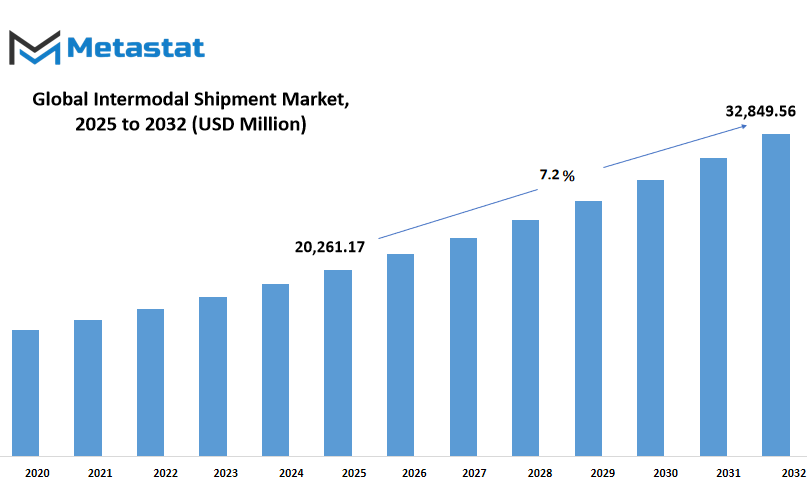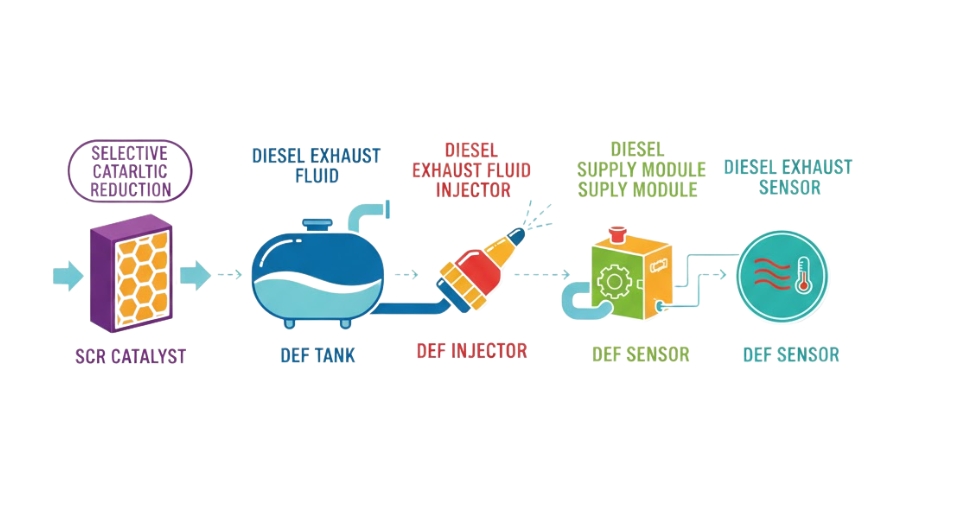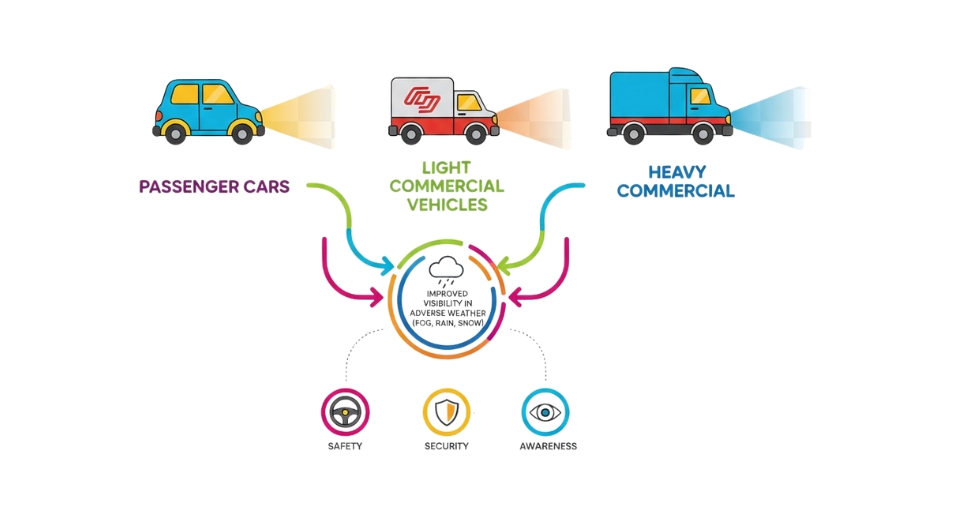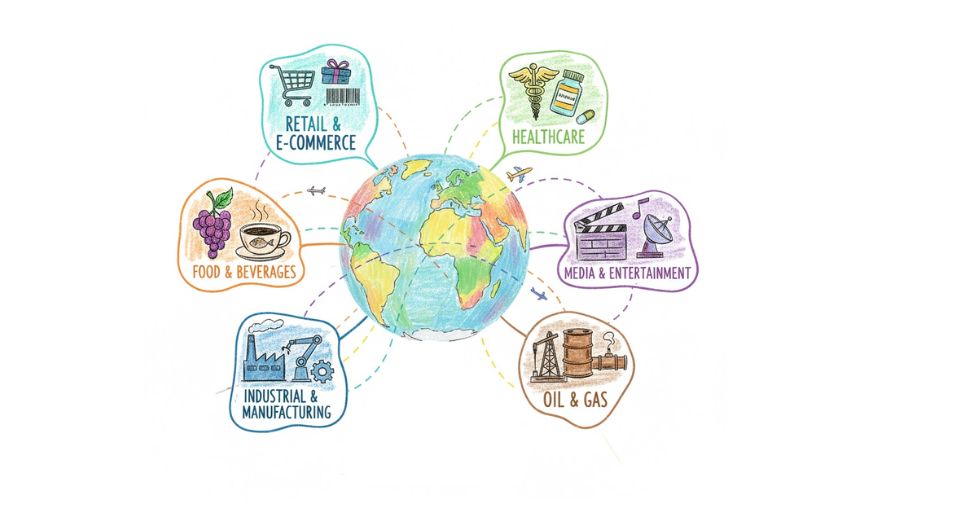MARKET OVERVIEW
The global intermodal shipment market is a dynamic business segment in the global transportation and logistics sector, further capturing growing interest as companies continue to increase operations across borders. Sitting at the interface of different modes of transport like rail, road, air, and sea, this market will define the future of the movement of goods efficiently and dependably. Beyond the typical conversations about container capacity or supply chain cost, the more profound narrative of this market is how it will reshape cooperation, productivity, and digital innovation in global supply chains.
In the near future, the global intermodal shipment market will not just concentrate on streamlining route management or turnaround time reduction. Rather, it'll revolutionize the very nature of global change networks. The growing need for transparency and traceability in international transport will guide investments into virtual infrastructure as well as sophisticated monitoring technologies. Intermodal shipping nodes will transition from being mere factors of transfer to becoming nodes of smart coordination, induced by the exchange of records across numerous stakeholders. Such systems will allow more desirable synchronization of schedules in addition to alignment of world supply styles.
As the globe gears up to adopt sustainability in trading practices, this market will be at the helm of affairs during the transition. Intermodal transport arrangements, which generally support lower emissions per unit of product than single-mode options, will gain popularity among companies seeking to achieve environmental standards. This transformation will not just change the movement of freight but will shape the design of cargo containers, the application of electric or hydrogen-fueled transport vehicles, and the introduction of renewable power in terminal facilities.
Yet another transformation in the pipeline is the impact of geopolitical changes and regional trade practices. As nations redefine their alliances and supply chains, intermodal shipping networks must become more adaptable. The global intermodal shipment market will witness a rebuilding of trade routes, with focus on cross-border efficiency more than port-to-port speed. This adjustment will give rise to new corridors, spur regional logistics ecosystems, and allow smaller economies to engage more actively in international trade exchanges.
In addition to this, the talent pool in this industry will see a change as well. Intermodal logistics professionals will have to possess digital capabilities and cross-functional knowledge. While automation and machine learning become increasingly significant factors in streamlining transport flows, human supervision will shift to emphasize analytics, decision-making, and strategic monitoring over physical coordination.
From a business perspective, the future of the global intermodal shipment market will not be all about capacity and volume. The worth of intermodal service will be in reliability, predictability, and technological advantage. Companies will select vendors now not simply on the basis of charge or insurance however also on whether or not they can plug into an included worldwide digital deliver chain.
In brief, the global intermodal shipment market will grow to be a strategic force for international trade, supported by means of technological convergence, regulatory evolution, and ecological consciousness. As global alternate keeps to develop, this segment will deliver into play newly rising possibilities that pass a whole lot past the conventional realm of logistics.
Global intermodal shipment market is estimated to reach $32,849.56 Million by 2032; growing at a CAGR of 7.2% from 2025 to 2032.

GROWTH FACTORS
The global intermodal shipment market is slowly transforming into a more dynamic system as companies look for smarter, faster, and cheaper ways of transporting goods between different regions. Companies are increasingly utilizing intermodal transportation not only for cost reductions, but also because it is fuel-efficient and can combine various modes of transport into one integrated journey. With international trade and Internet shopping on the up, there is increasing pressure to be able to change logistics systems rapidly between road, rail, air, and sea without the associated delays and costs of more rigid systems.
However, in spite of the drive toward more intelligent solutions, there are many hurdles that remain. In most regions, dysfunctional or antiquated infrastructure complicates easy switching between modes of transport. Also, coordinating logistics in international locations with varying guidelines, standards, and paper-based totally systems has a tendency to motive delays and overlooked time limits. These issues don't simplest worsen supply chains they value time, capital, and credibility.
In the future, the arrival of greater sensible logistics structures and real-time tracking will offer much-wanted comfort. As virtual technologies come to be greater advanced, shipments may be tracked greater intensively, delays can be forecast and eliminated, and transfers between transport modes may be less complex. These innovations will no longer simplest beautify delivery time but additionally permit corporations to better plan routes and control stock. As corporations depend more and more on international connections, the circulate towards smarter, greater networked intermodal answers will probably not only be useful but vital.
MARKET SEGMENTATION
By Mode of Transport
The global intermodal shipment market is gaining large traction as corporations and governments are seeking faster, extra fee-efficient, and environmentally conscious approaches to move items. By the use of a combination of transport strategies such as rail, trucks, ships, and planes intermodal shipping allows streamline operations and decrease coping with costs. This method gives flexibility in logistics, making it less complicated to transport freight throughout lengthy distances, whether or not it's within a continent or among countries. The call for a easy and related freight system maintains to develop, specially with the steady upward thrust in e-commerce, production, and worldwide change.
Within the global intermodal shipment market, delivery modes play a primary position in shaping how items are moved from origin to vacation spot. Rail transport sticks out, with a recorded price of $10,292.68 million. It remains a reliable option for bulk and lengthy-haul transport, imparting a stability among velocity and fee. Rail also helps greener tasks due to its decrease carbon footprint compared to trucks and planes. Truck transport, then again, stays a dominant choice for quick-distance hauls and remaining-mile transport. Its capacity to attain far off or urban regions that rail can't makes it a important hyperlink within the chain.
Maritime shipping holds sturdy relevance in intercontinental transport, particularly for huge volumes of goods. Although slower in comparison to different modes, it remains reasonably priced for bulk cargo. Ports across the world have visible investments in infrastructure to assist box handling and intermodal transfer. Air shipping, whilst commonly used for time-touchy or excessive-cost shipments, provides velocity to the logistics network. Its role, even though more restricted in quantity, is critical in cases where urgency subjects more than value.
The intermodal version reduces delays because of disruptions in one precise transport channel. If one mode faces a bottleneck, the others can be adjusted to hold delivery timelines. This flexibility enables groups manage their deliver chains with extra manage. Technological advancements, like actual-time tracking and automated box handling, are also making intermodal delivery smarter and more conscious of global demands.
Overall, the intermodal shipment market will keep to help the spine of worldwide exchange. By linking a couple of transport structures into a unmarried movement plan, it gives a realistic method to the demanding situations of current logistics. As industries develop and exchange routes make bigger, this market will not simplest adapt it's going to assist lead the shift in the direction of smarter, faster, and cleanser freight delivery.
By Type of Cargo
The global intermodal shipment market continues to evolve as exchange demands grow and transportation systems come to be greater included. One of the main approaches this marketplace is labeled is through the type of shipment being transported. Each cargo type plays a specific role in shaping how intermodal structures function across borders and areas.
Containers constitute a main section in this class. They provide a standardized, green manner to transport goods over long distances the use of one-of-a-kind modes of shipping together with ships, trains, and vans. The flexibility and protection packing containers provide lead them to the favored desire for delivery a extensive range of client merchandise, electronics, and industrial materials. Their ease of managing and decreased need for manual intervention allow quicker transfers among shipping modes, which saves both time and exertions.
Bulk goods, on the other hand, encompass huge volumes of unpackaged materials like coal, grain, minerals, and chemical substances. These are typically moved using specialized coping with systems designed to accommodate their size and nature. Because bulk cargo often comes with specific garage and shipping wishes, infrastructure performs a big role in making sure the easy movement of such goods. Although they'll no longer be as clean to handle as containerized goods, bulk shipments remain essential for industries inclusive of power and agriculture.
General cargo includes gadgets that do not fall underneath containerized or bulk classes. These can range from machinery and cars to packaged goods that require distinctive dealing with techniques. This category frequently requires more tailor-made solutions because of varying shapes, sizes, and managing desires. While it is able to no longer offer the equal degree of efficiency as boxes, general cargo nonetheless holds significance for industries where customization and care are vital in the course of delivery.
Together, those shipment kinds help shape how the global intermodal shipment market grows and responds to trade patterns. Their particular coping with necessities influence no longer most effective the infrastructure used but additionally the kind of investment made in logistics and delivery structures. As corporations maintain to seek faster, safer, and more fee-effective delivery solutions, the role of every shipment type in intermodal delivery will continue to be essential.
By Shipment Duration
The global intermodal shipment market has been gradually reshaping how items pass throughout countries and continents. With a growing need for quicker, greater reliable transportation options, groups are turning to intermodal answers that combine extraordinary modes of transport which include rail, avenue, and sea without dealing with the freight itself whilst converting from one mode to another. This technique facilitates improve efficiency and decrease prices whilst assisting well timed deliveries. As on-line buying keeps to influence logistics strategies, agencies are setting extra consciousness on shipping timeframes to fulfill rising customer expectancies.
When it comes to cargo length, the marketplace is broadly segmented into 4 classes Same Day Delivery, Next Day Delivery, Standard Delivery (2–5 Days), and Long-Haul Delivery (5+ Days). Each of those serves a specific purpose depending at the form of product, vacation spot, and patron demand. Same Day and Next Day deliveries have become extra commonplace in metropolitan regions, especially for industries like e-commerce and medical components in which speed topics. These time-sensitive alternatives require tremendously coordinated operations, frequently supported by using avenue and air delivery operating in tandem.
Standard Delivery, which usually takes among 2-5 days, nonetheless holds a enormous share in the intermodal shipment landscape. It's seen as a balance between velocity and cost, making it a famous desire for many organizations. Products that don’t require instant shipping, consisting of clothing or non-perishable goods, frequently fall into this class. The flexibility of this option permits groups to apply rail delivery for long distances and switch to vans for neighborhood distribution, optimizing each time and fee.
Long-Haul Delivery, which extends past 5 days, generally includes pass-border or global movement. While it could take longer, it's a cost-effective choice for bulky items, business substances, or shipments headed to far off places. These deliveries often rely upon a combination of sea and rail delivery and are desired when the arrival time isn't always urgent. Even with longer timelines, there's a robust push for greater visibility and monitoring to make certain reliability.
As corporations keep to adapt to converting customer conduct and supply chain pressures, the global intermodal shipment market will keep transferring towards smarter, more bendy transport fashions. Whether it’s getting a bundle across metropolis inside hours or delivery equipment remote places over every week, having a couple of shipment duration alternatives offers groups the agility to fit the velocity of world trade.
By End-User Industry
By stop-person enterprise, the global intermodal shipment market is extensively divided into sectors consisting of Manufacturing, Retail and E-trade, Agriculture, Pharmaceuticals, Automotive, and Construction. Each of those industries plays a completely unique role in shaping the demand for intermodal shipping, pushed by using the growing want for green, cost-powerful, and dependable movement of products throughout various places.
Manufacturing continues to be one of the maximum energetic users of intermodal shipment, as factories rely heavily on consistent, huge-scale transportation networks to move raw substances and finished merchandise. The potential to combine unique transportation modes which include rail and truck makes it less difficult to satisfy production schedules without delays or high logistics prices. As global supply chains increase, manufacturers are expected to make investments greater in intermodal answers to stay aggressive and decrease environmental impact.
Retail and E-trade have seen a rapid surge in intermodal shipping wishes, particularly with the upward thrust of online purchasing. Customers now assume faster deliveries, even throughout long distances, and groups are searching out methods to hold up without elevating fees. Intermodal shipping offers an answer that blends speed with affordability. As more businesses shift to on line platforms, this phase will probably keep using demand for integrated logistics services.
In the Agriculture sector, well timed delivery is critical. Crops and perishable items want to attain processing devices or markets fast to hold fine. Intermodal cargo helps bridge long distances even as preserving freshness via the use of green hand-offs among shipping kinds. The seasonal nature of agriculture additionally pushes for bendy logistics structures, and intermodal shipping fits that requirement well.
Pharmaceutical agencies rely on transportation strategies that are stable, punctual, and compliant with fitness requirements. The managed environments needed for plenty drug treatments and clinical equipment call for dependable answers. Intermodal transport, with its trackable and constant operations, supports this industry’s want for timely and secure delivery, particularly over international routes.
The Automotive enterprise offers with bulky and regularly sensitive components that want to be transported among providers and assembly devices. Intermodal shipment offers a realistic option for shifting these components with out harm, mainly over lengthy distances. It additionally facilitates producers optimize routes and decrease downtime in manufacturing by making sure additives arrive when needed.
Construction agencies want a steady deliver of materials like cement, steel, and machinery to keep tasks on course. These materials are often heavy and sourced from distant providers. Intermodal shipping enables control those actions easily by using combining rail for lengthy hauls and vans for ultimate-mile delivery, making it less complicated to manage fees and schedules.
|
Forecast Period |
2025-2032 |
|
Market Size in 2025 |
$20,261.17 million |
|
Market Size by 2032 |
$32,849.56 million |
|
Growth Rate from 2025 to 2032 |
7.2% |
|
Base Year |
2024 |
|
Regions Covered |
North America, Europe, Asia-Pacific Green, South America, Middle East & Africa |
REGIONAL ANALYSIS
The global intermodal shipment market is fashioned with the aid of local dynamics that affect how goods are moved and managed throughout borders. In North America, the marketplace sees a robust presence within the U.S., Canada, and Mexico. The U.S., with its substantial infrastructure and change networks, continues to play a central position in using marketplace growth. Canada and Mexico also make contributions notably, with move-border alternate agreements and coordinated logistics structures supporting to streamline cargo tactics across the location. Together, these countries have created an green machine that balances avenue, rail, and port operations, which allows intermodal transportation to paintings easily and on a large scale.
Across Europe, the intermodal shipment market operates via a combination of mature and emerging economies. The UK, Germany, France, and Italy are key players, every bringing their own infrastructure strengths to the table. Germany, as an example, benefits from a sturdy railway network and properly-organized freight corridors, while the United Kingdom continues strategic port get right of entry to and distribution centers. The call for sustainable shipping alternatives is likewise growing in this area, pushing companies to adopt more environmentally pleasant intermodal techniques. Rest of Europe maintains to adapt, supporting the overall market with developing investments in freight networks and partnerships across international locations.
Asia-Pacific holds a number of the quickest-growing economies, with India, China, Japan, and South Korea forming the muse of the local intermodal network. China, particularly, plays a first-rate role, way to its massive-scale production and export gadget. Japan and South Korea advantage from superior logistics era and automation, which help increase the performance in their intermodal operations.
In South America, Brazil and Argentina stand out for his or her contributions to the intermodal shipment market. Brazil’s ports and rail structures are principal to nearby alternate, mainly in agricultural and industrial products. Argentina also sees increasing improvement in freight shipping structures, supported by using a growing hobby in linking avenue and rail. Although some regions face infrastructure challenges, the Rest of South America is slowly enhancing its logistics structures with new investments and government guide.
The Middle East & Africa region brings collectively a mix of set up and developing intermodal systems. The GCC Countries, which includes nations just like the UAE and Saudi Arabia, are pushing ahead with big infrastructure initiatives geared toward enhancing freight connectivity. Egypt serves as a strategic exchange point because of its access to the Suez Canal, whilst South Africa remains one of the maximum superior logistics hubs within the southern a part of the continent. Other components of the place are catching up with efforts to upgrade rail strains, ports, and motorway networks to guide the developing want for green shipment answers.

COMPETITIVE PLAYERS
The global intermodal shipment market is steadily shaping the way items are transported across big distances. With an growing push towards efficient logistics and timely deliveries, the enterprise has turn out to be a essential part of the worldwide supply chain. Intermodal shipping, which makes use of more than one mode of delivery like rail, street, and every so often air or inland water, has emerged as a smarter solution to meet the demands of quicker, less expensive, and environmentally conscious freight motion. This shift isn’t pretty much saving time it’s about using the strengths of every transportation mode to triumph over bottlenecks and enhance common reliability. Businesses are knowing that mixing modes can assist cut prices and hold shipments moving, even if one part of the community faces disruptions.
Many companies are leaning into this approach, no longer most effective for the fee advantages however also to navigate demanding situations like street congestion, driving force shortages, and fluctuating gas costs. The flexibility of switching among shipping modes reduces dependency on any single approach, which has end up a real advantage, particularly in regions in which infrastructure limits direct lengthy-haul routes. What was once considered as a complicated manner to move freight is now turning into the standard for plenty principal carriers and their customers. Shippers need consistency and tracking, and these days’s tech-subsidized logistics services make that viable even across more than one legs of a adventure.
Several massive names are steering the boom of the global intermodal shipment market with their expansive networks and logistics expertise. Companies along with JB Hunt, Hub Group, XPO, Schneider, and Knight-Swift are a number of the well-known operators presenting superior intermodal answers. They’ve invested in systems that hold supply chains seen, reliable, and related. Alongside them, companies like LeeWay Global Logistics, C.H. Robinson, and CLX Logistics deliver tailor-made offerings that in shape both home and international shipping demands. These players have carved out a stable presence via combining provider flexibility with digital equipment that simplify coordination between truckers, rail operators, and ports.
Smaller yet influential individuals consisting of ContainerPort Group, ITI Intermodal, Intermodal Shippers Group, and BR Williams Trucking preserve to assist the market by means of managing regional and mid-scale shipping desires with sharp execution. International firms like PJSC Far Eastern Shipping Company and Neptune Logistics have also performed a part in constructing stronger hyperlinks among international markets. By integrating their operations with countrywide vendors and freight partners, they make pass-border delivery feel much less fragmented. Their services open up access to exchange routes that could in any other case be hard for unbiased corporations to navigate by myself.
Going ahead, intermodal cargo will possibly become even more vital as agencies are searching for smarter logistics to guide each e-commerce and traditional retail. While the market nonetheless faces challenges round infrastructure and regulatory alignment, the overall direction stays clean greater companies are shifting closer to answers that prioritize speed, cost manipulate, and adaptableness. With more collaboration between tech and delivery companies, intermodal logistics will retain to enhance and assist reshape how goods reach their destinations international.
Intermodal Shipment Market Key Segments:
By Mode of Transport
- Rail Transport
- Truck Transport
- Maritime Transport
- Air Transport
By Type of Cargo
- Containers
- Bulk Goods
- General Cargo
By Shipment Duration
- Same Day Delivery
- Next Day Delivery
- Standard Delivery (2-5 Days)
- Long-Haul Delivery (5+ Days)
By End-User Industry
- Manufacturing
- Retail and E-commerce
- Agriculture
- Pharmaceuticals
- Automotive
- Construction
Key Global Intermodal Shipment Industry Players
- JB Hunt
- Hub Group
- XPO
- Schneider
- Knight-Swift
- LeeWay Global Logistics
- C.H. Robinson
- CLX Logistics
- ContainerPort Group
- ITI Intermodal
- Intermodal Shippers Group
- BR Williams Trucking
- PJSC Far Eastern Shipping Company
- Neptune Logistics
WHAT REPORT PROVIDES
- Full in-depth analysis of the parent Industry
- Important changes in market and its dynamics
- Segmentation details of the market
- Former, on-going, and projected market analysis in terms of volume and value
- Assessment of niche industry developments
- Market share analysis
- Key strategies of major players
- Emerging segments and regional growth potential








 US: +1 3023308252
US: +1 3023308252






